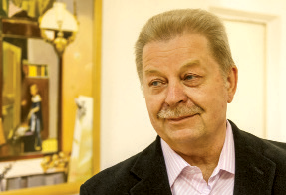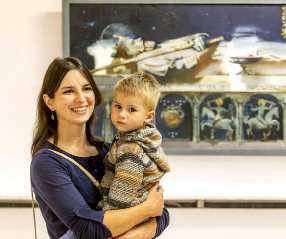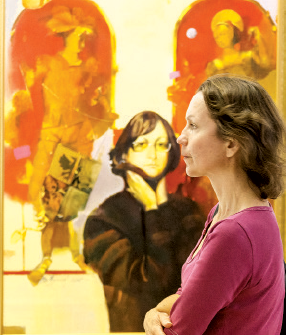Personal exhibition of works by People’s Artist Vladimir Tovstik opens at Modern Fine Arts Museum
 I once asked Vladimir Tovstik why, being well known as an artist, laureate, professor and head of chair, he chooses to walk or use public transport rather than drive (unlike many colleagues). Shrugging his shoulders, he admitted that he finds it more convenient, and is rarely in a hurry. He enjoys walking through his native city and has never had a feeling for ‘technology’.
I once asked Vladimir Tovstik why, being well known as an artist, laureate, professor and head of chair, he chooses to walk or use public transport rather than drive (unlike many colleagues). Shrugging his shoulders, he admitted that he finds it more convenient, and is rarely in a hurry. He enjoys walking through his native city and has never had a feeling for ‘technology’.It’s true that we fail to experience the heart of a city when travelling by car. Only by taking our time, walking, stopping, watching those around us, admiring buildings and reflexions in windows, and perusing shop-windows, do we gain a sense of Minsk’s spirit. The old bricks, bright golden domes, ancient wine-red tiles, pigeons flying up from under our feet, the red leaves falling from maple trees, iron railings and shadows on the pavement create their own artistic symphony.
Mr. Tovstik’s canvases present meticulous details of city life: today and from the past. Interestingly, such details peacefully co-exist, even having a silent dialogue. They are the work of many hours: his cupboard is filled with albums of quick pencil sketches, from which all imagination grows. Near the unfinished picture on his easel, albums lie open, having been used for inspiration. The lilies in the sketches have become flowers painted in oil, surrounded by trees, clouds, lanterns, buildings, people and birds. They are one fragment of city life, without which the scene would be empty and lifeless. Mr. Tovstik often paints alongside his students, encouraging them through his own labours.
Several days before the exhibition launch, I met Vladimir at his studio, to view his canvases and discover what inspires him. Already in their frames, ‘dressed’ for show, the pictures appeared to look back at us.
 Mr. Tovstik reveals, “My exhibition is small in scale, without pathos. I’ve always enjoyed visiting different cities: some meetings were short, but memorable. In Italy, I felt at home — perhaps because of having studied the history of art. Having viewed so many reproductions and photos, everything seemed familiar. In Urbino city, where Raphael was born, I viewed Piero della Francesca’s Flagellation of Christ. I’d always thought of it as a big canvas, as it uses the rules of monumental painting; however, to my surprise, it is painted upon a small dark board, which appears bored by beetles. Then, walking through the city, I realised that, despite five centuries having passed, the buildings and the city’s silhouette remain recognisable from the painting. It shows everything: light and dark. This is what makes it special, and excites spectators.”
Mr. Tovstik reveals, “My exhibition is small in scale, without pathos. I’ve always enjoyed visiting different cities: some meetings were short, but memorable. In Italy, I felt at home — perhaps because of having studied the history of art. Having viewed so many reproductions and photos, everything seemed familiar. In Urbino city, where Raphael was born, I viewed Piero della Francesca’s Flagellation of Christ. I’d always thought of it as a big canvas, as it uses the rules of monumental painting; however, to my surprise, it is painted upon a small dark board, which appears bored by beetles. Then, walking through the city, I realised that, despite five centuries having passed, the buildings and the city’s silhouette remain recognisable from the painting. It shows everything: light and dark. This is what makes it special, and excites spectators.”I approach the canvas Vladimir holds up for me, wishing to look closer, and see our city’s Pervomaiskaya Street, a park, a hill with pines, and an old-fashioned tram on the street. Such trams are a thing of the past, scattering sparks only in memoirs, old films and photos. The picture is easily recognisable and needs no comment. Like a photo from a family album, the painting is relaxed and natural. It might have been taken at the single press of a button. I can see that he has captured something which no longer exists: Minsk is changing.
In outward appearance, my works are similar to photos, but I add my own invention, viewing each as a story to be told: a composition comprising dozens of fragments drawn from various times, across various cities — sometimes separated by several thousand kilometres
Vladimir explains, “In outward appearance, my works are similar to photos, but I add my own invention, viewing each as a story to be told: a composition comprising dozens of fragments drawn from various times, across various cities — sometimes separated by several thousand kilometres. I try to depart from photographic accuracy, to follow the laws of art. When people buy a picture to take home, they wish to acquire something that speaks to them, with its own aura — like an icon. The picture should help and protect them.”
 He shows me another canvas, saying, “I remember a different Minsk: even the day Stalin died. Just imagine how much time has passed — although it sometimes feels like yesterday. During recent years, our city has changed significantly, gaining a true centre, with its symbolic buildings restored. There’s a new feel to the place, reflecting how people have changed. We used to have only our avenues, the Opera Theatre and the Academy of Sciences. Now, women dress far more elegantly, as they do in Prague, Rome, Kraków, Warsaw, Vilnius and Florence. I’ve seen them, so I know! All my observations are in my pictures. Do you remember Édouard Manet’s Bar at the Folies-Bergère? All that was more than one hundred years ago — yet I saw the same girl and the same cafe today. I saw and then painted.”
He shows me another canvas, saying, “I remember a different Minsk: even the day Stalin died. Just imagine how much time has passed — although it sometimes feels like yesterday. During recent years, our city has changed significantly, gaining a true centre, with its symbolic buildings restored. There’s a new feel to the place, reflecting how people have changed. We used to have only our avenues, the Opera Theatre and the Academy of Sciences. Now, women dress far more elegantly, as they do in Prague, Rome, Kraków, Warsaw, Vilnius and Florence. I’ve seen them, so I know! All my observations are in my pictures. Do you remember Édouard Manet’s Bar at the Folies-Bergère? All that was more than one hundred years ago — yet I saw the same girl and the same cafe today. I saw and then painted.”Speaking of his students, he admits that it’s ‘difficult to teach’ since youngsters today tend to be ‘mistrustful and well-informed’. He notes, “They’ve already seen and travelled a great deal, so they think they know much. If you tell them something, you must be convincing, demonstrating effectively. To do so, you need to have a certain professional level. It was true even some time ago, when I studied.”
At the exhibition opening, standing in a crowd of the artist’s friends and admirers, I recall our long acquaintance and casual meetings in the city. Such exhibitions allow an artist to communicate with spectators, and there are many here today. The day afterwards, I meet him again, near the entrance to the children’s park. He is going to visit his mother, with a bouquet of white lilies: heading to Pervomaiskaya Street.











